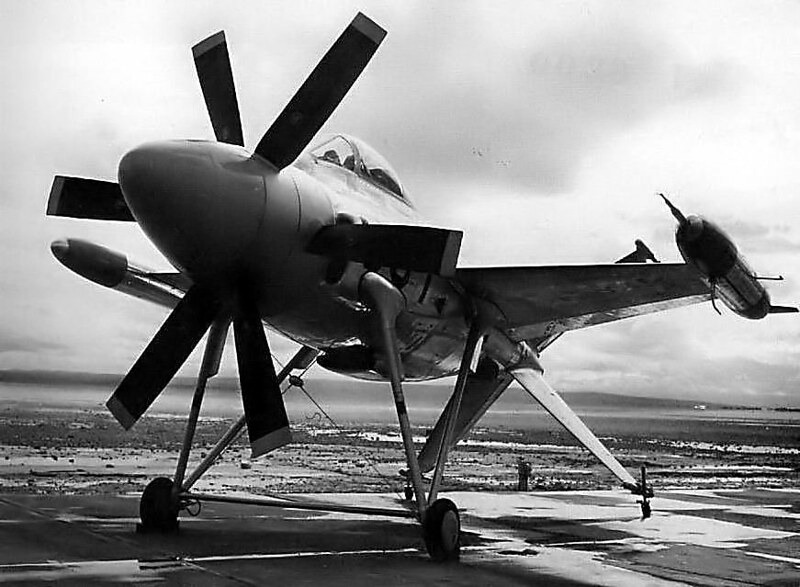- Yes
- No
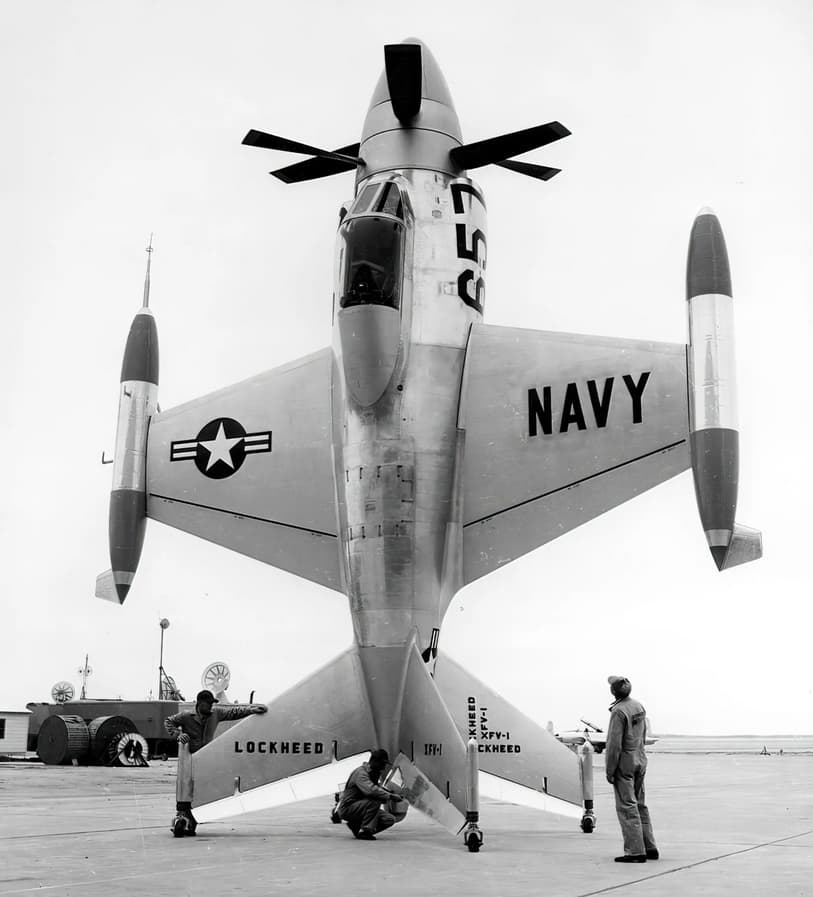
Hello everybody. I’d like to introduce and suggest the Lockheed XFV-1 for the US Aviation tech tree in War Thunder. This experimental “tailsitter” prototype, developed by Lockheed in the early 1950s, was designed to explore the feasibility of shipborne VTOL fighters capable of operating from confined deck spaces on conventional ships to protect convoys.
History
BackgroundIn 1947, both the US Air Force and Navy initiated VTOL design studies under Project Hummingbird to assess the potential role of vertical takeoff and landing aircraft in future conflicts. The Air Force specifically emphasized the need for VTOL fighters, concerned that Soviet attacks could rapidly overwhelm conventional airfields. Simultaneously, the Navy - drawing from its combat experience against Japanese kamikaze attacks - sought to equip all ships, from destroyers to transports, with VTOL fighters for self-defense in hostile waters.
By 1948, the Navy expanded these studies, incorporating insights from captured German documents about the Focke-Wulf Triebflügel, an innovative tailsitter VTOL ramjet fighter concept. The resulting requirements called for fighters that could be stored vertically in shipboard “tepee” structures, ready for immediate launch to intercept threats until carrier-based reinforcements could arrive.
On May 31, 1951, the Navy awarded contracts to Convair and Lockheed to develop practical VTOL fighters, designated XFY-1 and XFV-1, respectively. Both were “tailsitters,” designed to stand vertically during takeoff and landing. They were powered by the experimental Allison XT40 turboprop engine, which combined two T38 engines through a single gearbox to drive counter-rotating propellers, a configuration also used in the Douglas XA2D-1 Skyshark and Convair R3Y Tradewind. The XT40 delivered an exceptional thrust-to-weight ratio exceeding 1:1, enabling true hover and vertical flight. Both designs were intended to use the more powerful Allison T54, though this engine never materialized for the program.
Lockheed XFV-1 Design FeaturesLockheed’s XFV-1 prototype featured a conventional fuselage with straight wings that bore strong similarities to the company’s later F-104 Starfighter design. The aircraft incorporated a distinctive cruciform tail arrangement with fins set at 45° angles, equipped with castor wheels for ground maneuvering when in a vertical position. Notably, the design omitted conventional wing control surfaces, concentrating all flight controls on the tail fins and trim tabs. The planned armament configuration included either 2 or 4 x 20 mm guns or 48 folding-fin rockets in wingtip pods, though these weapons were never actually installed. One of the most innovative features was a rotating reclining pilot seat designed to automatically adjust position during transitions between vertical and horizontal flight orientations.
Flight Testing ProgramThe Navy ordered two XFV-1 prototypes on April 19, 1951. The first aircraft arrived at Edwards AFB in October 1953, outfitted with temporary fixed landing gear to facilitate conventional testing while awaiting the vertical-flight configured T40 engines. During early high-speed taxi tests, the aircraft performed several unauthorized brief “hops” along the runway. The official first flight occurred on June 16, 1954, reaching 10,000 feet to evaluate slow-speed flight characteristics. Test pilots reported the aircraft handled like a “rocketship,” responding dramatically to throttle inputs while proving particularly sensitive to power reductions. The testing revealed a dangerous tendency to stall at 60 mph, with the potential to enter an uncontrolled roll or spin.
During the June 16, 1954 test flight, which lasted 35 minutes, the XFV-1 demonstrated its ability to transition between conventional and vertical flight modes at altitude. The test pilot noted that once in vertical orientation, the aircraft maintained remarkably stable hover characteristics. However, the program never achieved complete VTOL operations during the takeoff and landing phases due to the unavailability of the proper vertical-flight engines. The most significant operational challenge proved to be maintaining safe descent rates during vertical flight modes. Anyway, the test program ultimately completed 32 flights totaling 23 hours of flight time.
Program Termination and LegacyBoth the Lockheed and Convair VTOL programs produced technically successful aircraft, but persistent engine delays pushed first flights into 1954, by which time conventional aircraft performance had surpassed VTOL capabilities. The Navy also faced the reality that extensive specialized pilot training would be required for these unique aircraft. With the promised 7,100 shp Allison YT40-A-14 engine never materializing, the XFV-1 program officially concluded on June 16, 1955. The second prototype remained only partially completed, lacking a cockpit, engine, propellers, spinners, and wing tips.
The first prototype sustained damage during post-program testing but was later restored at the Sun-n-Fun Museum’s Buehler Restoration Center. It now resides on permanent outdoor display at the Florida Air Museum in Lakeland, Florida. The incomplete second prototype was placed on outdoor display at Los Alamitos Army Airfield in California.
Had the program continued, the production FV-2 variant would have featured several changes, incorporating a more powerful Allison T54-A-16 turboprop engine, nose-mounted radar system, comprehensive armor protection including bulletproof windshield, and full implementation of the planned armament systems.
Specifications
Lockheed XFV-1 “Salmon”General Characteristics
- Crew: 1 (Pilot)
- Length: 37 ft 6 in (11.43 m)
- Span: 27 ft 5 in (8.36 m)
- Wing Area: 246 sq ft (22.85 sq m)
- Propeller:
- Type: Curtiss-Wright turbo-electric six-bladed contra-rotating
- Diameter: 16 ft (4.88 m)
- Powerplant: 1 × Allison XT40-A-16 turboprop
- Takeoff: 6,825 shp (5,020 kW) @ 15,700 RPM
- Military: 6,955 shp (5,115 kW) @ 14,300 RPM
- Normal: 5,775 shp (4,250 kW) @ 14,300 RPM
- Internal Fuel: 508 US gal. (1,923 L)
- Oil Tankage: 12 US gal. (45.4 L)
- Weights:
- Empty: 11,742 lb (5,326 kg)
- Combat: 14,012 lb (6,356 kg)
- Max Takeoff: 16,250 lb (7,371 kg)
Performance (Estimates with YT40-A-16 engine @ Combat Weight)
- Speed:
- Max at Sea Level: 561 mph (903 km/h)
- At Altitude:
- 580 mph (930 km/h) @ 15,000 ft (4,572 m)
- 559 mph (900 km/h) @ 35,000 ft (10,668 m)
- Wing Loading: 61 lb/sq ft (298 kg/sq m)
- Rate of Climb: 11,840 ft/min (60 m/s)
- Time to Altitude:
- 2.9 minutes to 20,000 ft (6,096 m)
- 5.1 minutes to 30,000 ft (9,144 m)
- Service Ceiling: 43,600 ft (13,100 m)
Armament
- Armament:
- 4 × 20 mm Colt Mk. 12 Mod. 0 cannons (150 rounds per gun; 600 total) mounted in wingtip pods
OR- 48 × 70 mm rockets in wingtip pods
SAC Data
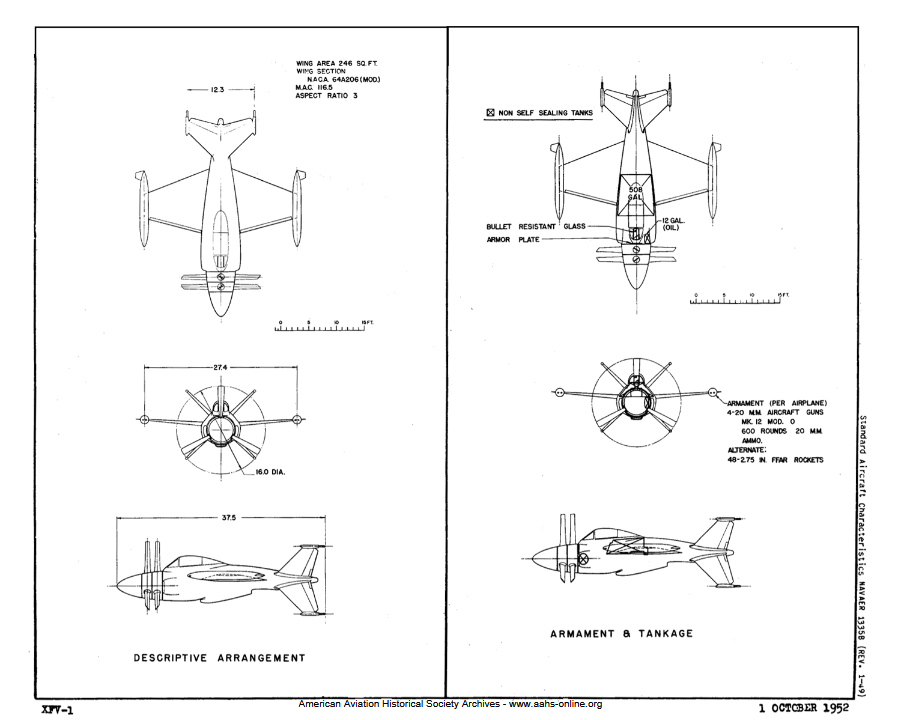
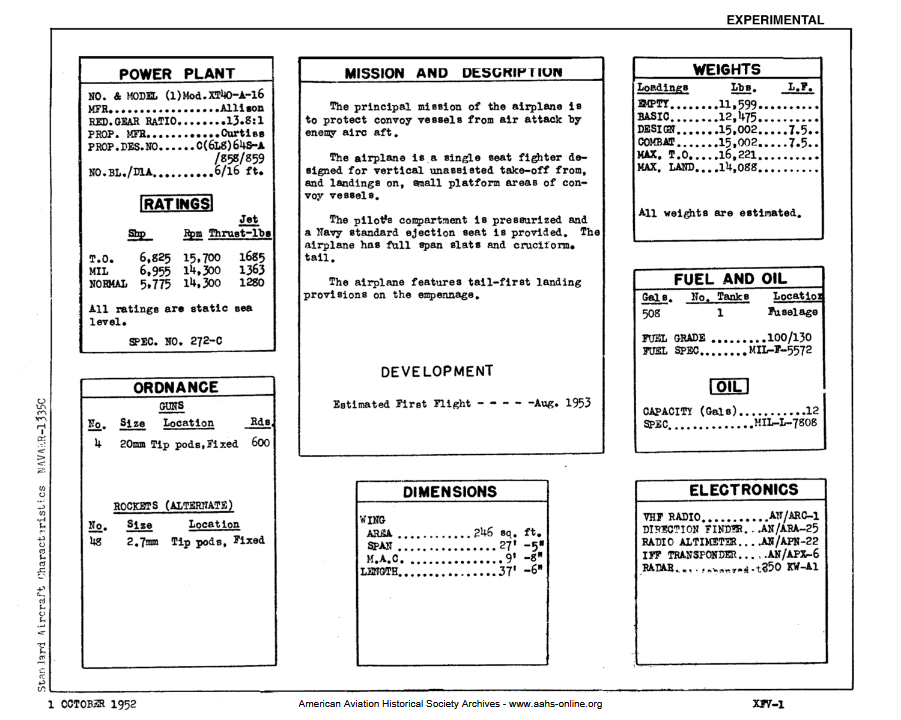
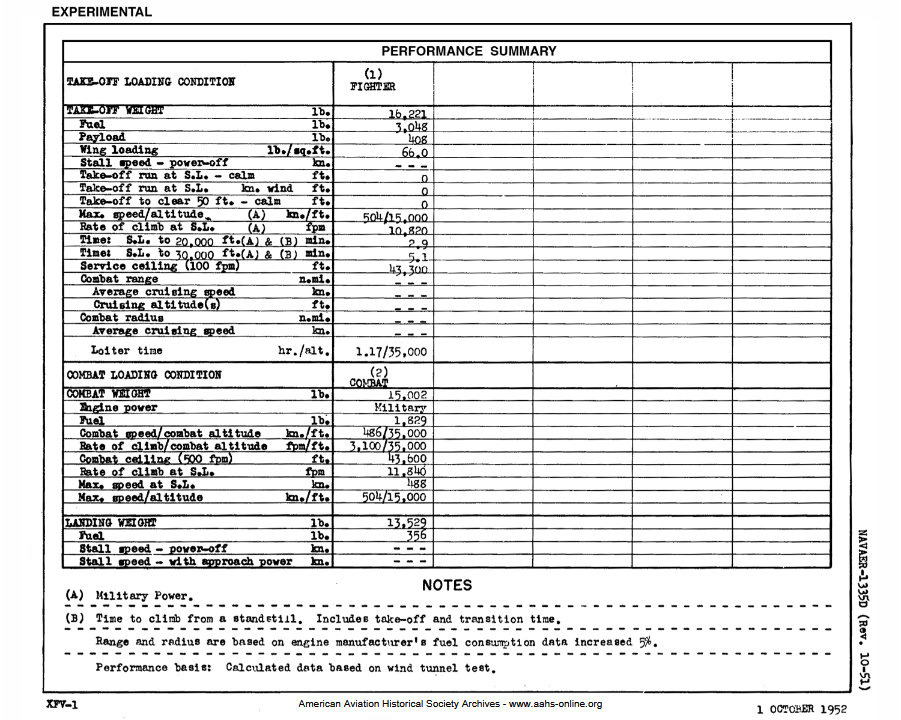
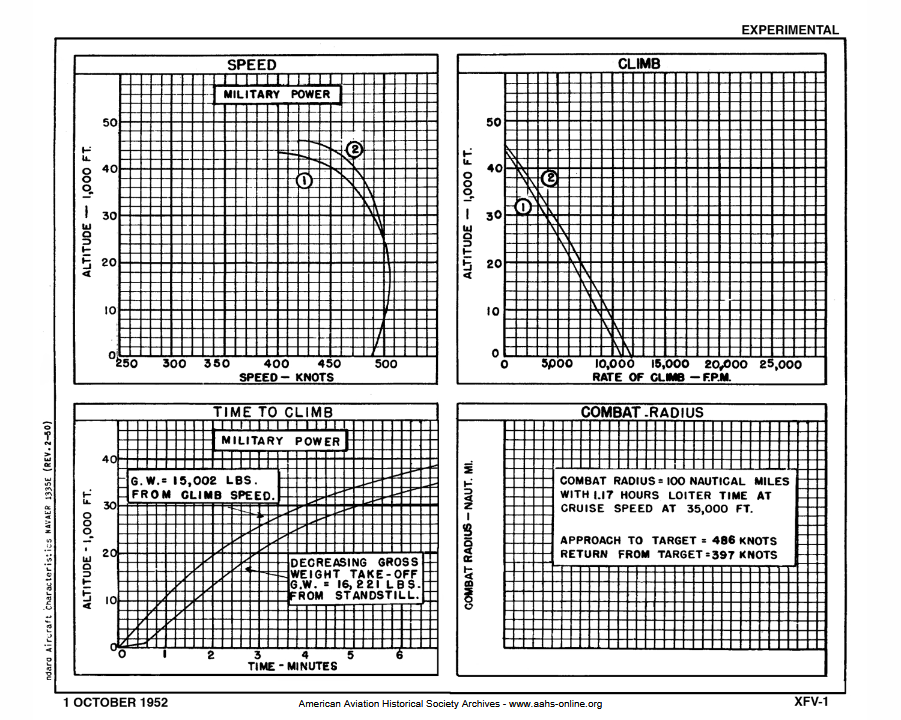
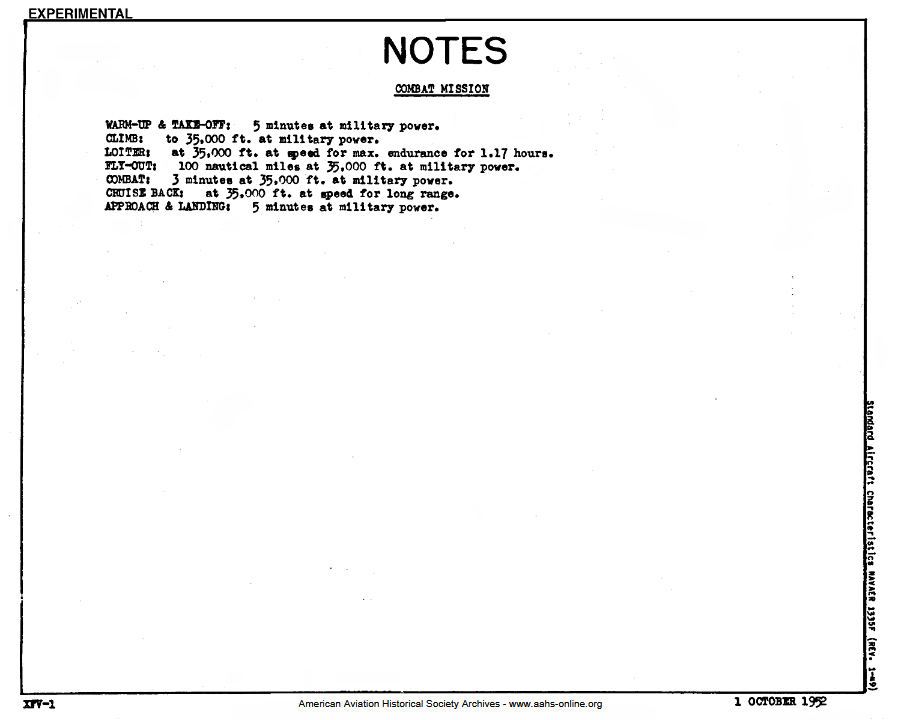
Diagrams
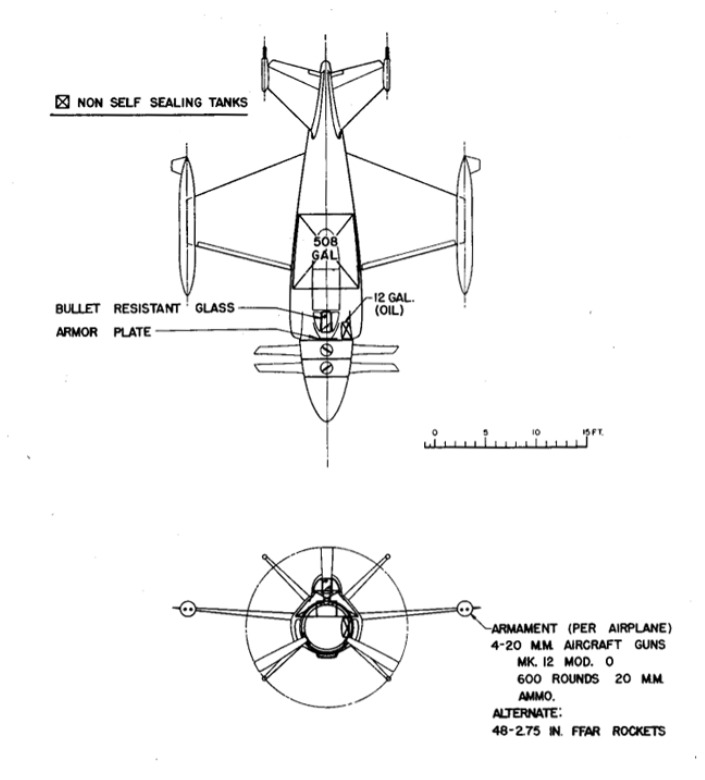
Cockpit
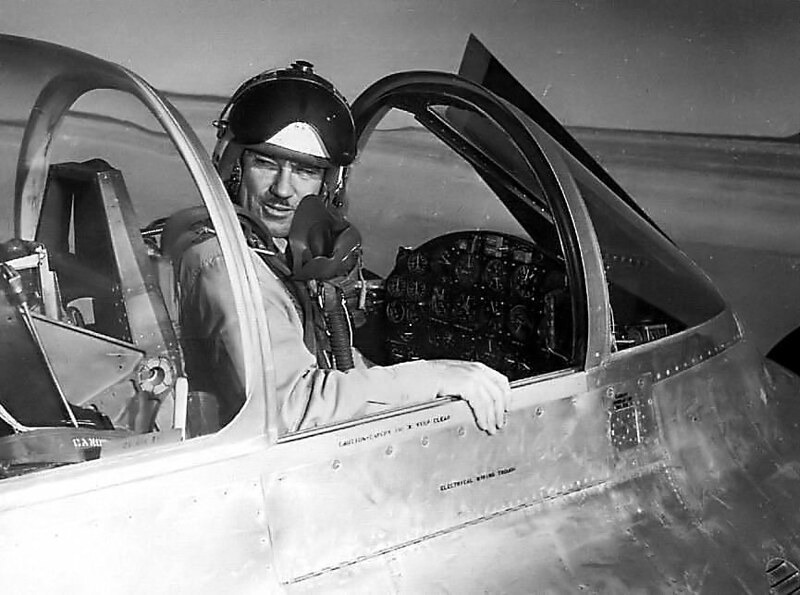
- Naval Fighters Number 32 - Lockheed XFV-1 - VTOL Fighter (1996)
- Standard Aircraft Characteristics XFY-1 (1 October 1952)
- Lockheed XFV - Wikipedia
- Lockheed XFV (Salmon) Vertical Take-Off and Landing (VTOL) Navy Fighter Aircraft Prototype
- Lockheed Salmon | Aircraft |
Thank you for taking the time to read my suggestion! 😃




